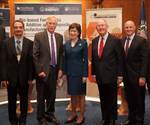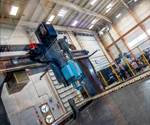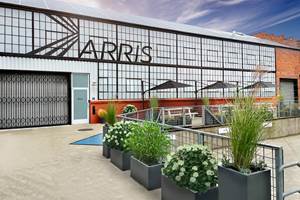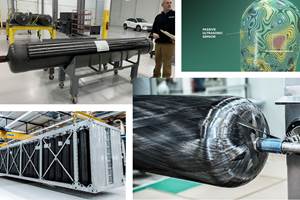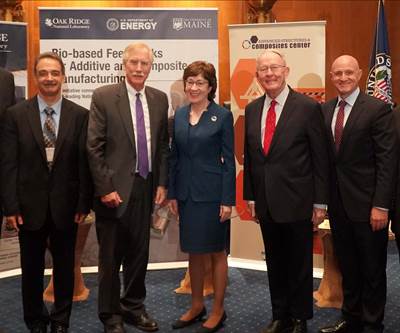UMaine awarded $2.8 million to accelerate AM wind blade development
Additive manufacturing with bio-based, 100% recyclable feedstocks reinforced with wood can reduce construction time by six months and cut costs by 25-50%
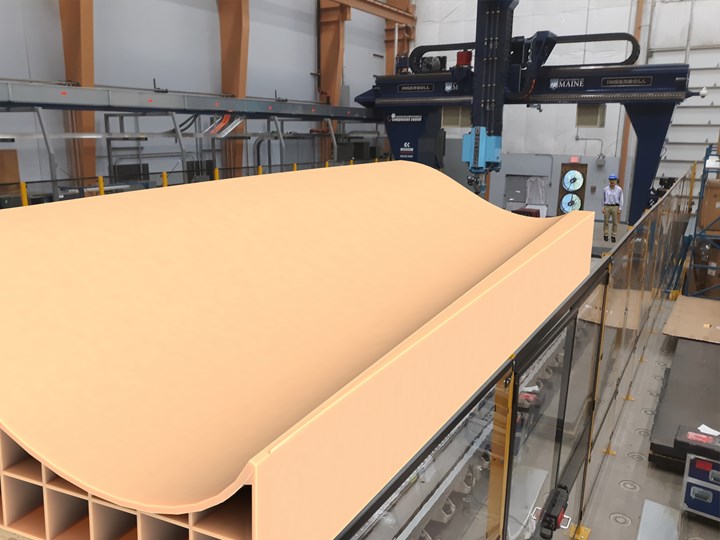
Rendering of a 3D-printed wind blade mold segment that will be produced as part of the ASCC's research effort to accelerate wind blade development through additive manufacturing. Photo Credit: UMaine ASCC
On Jan. 28, the University of Maine Advanced Structures and Composites Center (UMaine ASCC, Orono, Maine, U.S.) was awarded $2.8 million from the U.S. Department of Energy (DOE), Office of Energy Efficiency and Renewable Energy (EERE) to develop a rapid, low-cost additive manufacturing (AM) solution for fabricating large, segmented wind blade molds. Further, the UMaine Composites Center will be collaborating on a $4 million award to Oak Ridge National Laboratory (ORNL, Oak Ridge, Tenn., U.S.) to apply robotic deposition of continuous reinforcing fibers in wind blades.
Currently, innovation in large wind blade technology is a costly and time-intensive process. Molds and tooling for large blades can cost upward of $10 million, and, according to UMaine, time to market is typically 16–20 months, which stifles innovation.
“The University of Maine remains a leader in additive manufacturing and wind energy technology, and this funding will harness researchers’ expertise in both areas,” says Sens. Susan Collins and Angus King in a Jan. 28 announcement of the award. “We are thrilled that the Department of Energy continues to invest in UMaine’s cutting-edge research and prioritizes the advancement of our state’s clean energy economy and the creation of good-paying jobs.”
The large wind blade molds will be 3D printed on what is said to be the world’s largest polymer 3D printer located at the UMaine Composites Center. Mold development will incorporate the university’s nano- and micro-cellulose-reinforced thermoplastic composites reinforced with wood, which are said to promise mechanical properties similar to aluminum. The UMaine team estimates that new blade development costs can be reduced by 25% to 50% and accelerated by at least 6 months. Molds produced using these materials, will enable later reuse.
The outcome of the proposed research is to transform mold production as a key enabler for more rapid and more cost-effective large wind turbine blade development
Further, use of the bio-based materials will offer lower fabrication costs. Cost of the feedstock can be reduced to less than $2 per pound, compared to $5 per pound using carbon fiber-reinforced ABS thermoplastic feedstocks, a material widely used in large-scale 3D printing.
The molds will also incorporate 3D-printed heating elements using a new technology developed at ORNL. Control of mold surface temperatures is a critical mold manufacturing requirement, UMaine says, and the new ORNL technology enables robotic deposition of heating elements, reducing mold fabrication time and cost.
“Oak Ridge National Laboratory will apply expertise in additive manufacturing, carbon fiber technology and materials science to advance the use of 3D printing in wind energy applications,” says ORNL’s Xin Sun, interim associate laboratory director for energy science and technology. “We look forward to collaborating with UMaine to optimize these clean energy technologies to benefit the environment and boost the economy.”
The outcome of the proposed research is to transform mold production as a key enabler for more rapid and more cost-effective large wind turbine blade development. TPI Composites (Scottsdale, Ariz., U.S.) and Siemens Gamesa (SGRE, Zamudio, Spain) are partnering with the UMaine Composites Center on the project. Ingersoll Machine Tools (Rockford, Ill., U.S.) and Techmer PM (Clinton, Tenn., U.S.) are also partnering, providing the ability to scale-up both equipment and feedstock production.
Researchers at the UMaine Composites Center on the project include Dagher, James Anderson, John Arimond and Doug Gardner.
Related Content
Plant tour: Arris Composites, Berkeley, Calif., U.S.
The creator of Additive Molding is leveraging automation and thermoplastics to provide high-volume, high-quality, sustainable composites manufacturing services.
Read MoreASCEND program update: Designing next-gen, high-rate auto and aerospace composites
GKN Aerospace, McLaren Automotive and U.K.-based partners share goals and progress aiming at high-rate, Industry 4.0-enabled, sustainable materials and processes.
Read MoreWatch: A practical view of sustainability in composites product development
Markus Beer of Forward Engineering addresses definitions of sustainability, how to approach sustainability goals, the role of life cycle analysis (LCA) and social, environmental and governmental driving forces. Watch his “CW Tech Days: Sustainability” presentation.
Read MoreHexagon Purus Westminster: Experience, growth, new developments in hydrogen storage
Hexagon Purus scales production of Type 4 composite tanks, discusses growth, recyclability, sensors and carbon fiber supply and sustainability.
Read MoreRead Next
New research collaboration to advance efforts to 3D print with wood products
The ORNL and UMaine research team will work with the forest products industry to produce new bio-based materials that will be conducive to 3D printing a variety of products.
Read MoreUMaine Composites Center's 3D printer named world's largest
The university now holds world records for the largest prototype polymer 3D printer, largest solid 3D-printed object and largest 3D-printed boat.
Read More“Structured air” TPS safeguards composite structures
Powered by an 85% air/15% pure polyimide aerogel, Blueshift’s novel material system protects structures during transient thermal events from -200°C to beyond 2400°C for rockets, battery boxes and more.
Read More

